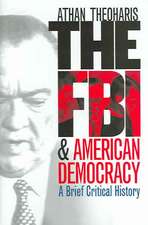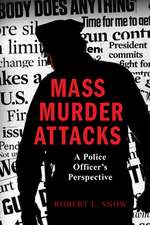Murder 101: Homicide and Its Investigation
Autor Robert L. Snowen Limba Engleză Hardback – 29 iul 2005 – vârsta până la 17 ani
Preț: 355.71 lei
Preț vechi: 415.11 lei
-14% Nou
Puncte Express: 534
Preț estimativ în valută:
68.07€ • 72.79$ • 56.75£
68.07€ • 72.79$ • 56.75£
Carte tipărită la comandă
Livrare economică 18 aprilie-02 mai
Livrare express 13-19 martie pentru 96.95 lei
Preluare comenzi: 021 569.72.76
Specificații
ISBN-13: 9780275984328
ISBN-10: 027598432X
Pagini: 224
Dimensiuni: 156 x 235 x 22 mm
Greutate: 0.51 kg
Ediția:New.
Editura: Bloomsbury Publishing
Colecția Praeger
Locul publicării:New York, United States
ISBN-10: 027598432X
Pagini: 224
Dimensiuni: 156 x 235 x 22 mm
Greutate: 0.51 kg
Ediția:New.
Editura: Bloomsbury Publishing
Colecția Praeger
Locul publicării:New York, United States
Notă biografică
Robert L. Snow has been a police officer with the Indianapolis Police for 34 years and is currently a captain and commander of the Homicide Branch. He is the author of The Militia Threat (1999), Looking for Carol Beckwith (1999), and Deadly Cults: The Crimes of True Believers (Praeger, 2003).
Cuprins
1 Murder in America2 The Crime Scene3 The Body4 Physical Evidence of Murder5 Interview and Interrogation6 Developing Suspects7 Cold Case Investigation8 The Trial9 Secondary Victims of MurderSome Final ThoughtsNotesBibliographyIndex
Recenzii
[T]he absolute abundance of knowledge that this book contains relating to homicide investigation is excellent. This is a detailed, accurate and at the same time very human journey and insight of a homicide investigator which was both a privilege to read and review.
[D]escribes how real-life cases work, from the meticulous work necessary to process physical evidence to investigation and interrogation techniques, developing suspects, working cold cases, and preparing for and participating in trials. He also includes a very good review of helping secondary victims (members of the community and victims' families) cope with the crime and its emotional consequences, including the realization that for many, closure will never be a possibility.
[D]escribes how real-life cases work, from the meticulous work necessary to process physical evidence to investigation and interrogation techniques, developing suspects, working cold cases, and preparing for and participating in trials. He also includes a very good review of helping secondary victims (members of the community and victims' families) cope with the crime and its emotional consequences, including the realization that for many, closure will never be a possibility.
























